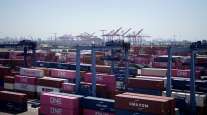Senior Reporter
Port Volumes Decline in August

[Stay on top of transportation news: Get TTNews in your inbox.]
Container volumes trended mostly into negative territory in August at facilities along the Pacific, Atlantic and Gulf of Mexico coasts, with a modest gain at the Port of Los Angeles being the only exception.
The L.A. port notched a 2.8% year-over-year gain in container volume during the month, moving 828,015 20-foot-equivalent containers, or TEUs, compared with 805,314 the previous year.
Executive Director Gene Seroka said the facility’s first monthly year-over-year increase in 13 months was helped along by renewed shipper confidence about availability of dockworkers to move shipments. Earlier this year, the International Longshore and Warehouse Union and management’s Pacific Maritime Association ratified a new five-year labor deal, putting an end to more than a year of contract talks that caused shipping volumes to plunge and business to shift to East and Gulf Coast ports.
“With this contract in effect through 2028, you can continue to count on our longshore workers and terminal operators to keep cargo moving through the nation’s busiest port,” Seroka said. “When we are operating on all cylinders like we are right now, there’s no better choice for cargo than the Port of Los Angeles.”
A just released economic impact report shows the Port of Oakland generates 98,345 local jobs. The Port’s overall economic value—from business revenue, consumer spending & the total value of goods and services—tops $174 billion. View details below. #portofoakland #economicimpact pic.twitter.com/XPKhmq0ZOy — Port of Oakland (@PortofOakland) September 19, 2023
However, the adjacent Port of Long Beach recorded what it’s calling a modest start to the traditional “peak” shipping season, as warehouses remained overstocked and consumers continued to pivot toward travel and other summertime activities.
The port reported a 15.4% year-over-year decline to 682,312 containers in August, compared with 806,940 the year before.
“We anticipated a modest peak season as our cargo numbers continue to stabilize at pre-pandemic levels,” Port of Long Beach CEO Mario Cordero, said. “Over the long term we are strengthening our competitiveness by investing in digital and physical infrastructure projects that will keep goods moving efficiently for decades to come.”
Even as year-over-year cargo volumes continue to slump at the Port of Oakland, a new report is touting the facility’s economic benefits and importance to Northern and Central California. The Martin Associates report shows the site’s overall economic value — which includes business revenue, consumer spending and total value of goods — increased 24%to $174 billion when measured against a similar study in 2017, which pegged the port’s value at $130 billion. The port generates 98,345 local jobs, making it the second-largest jobs generator in Oakland and fifth largest in the region.
That said, port container volumes still dipped 15.1% in August to 179,162 TEUs from 211,123 a year ago.
SeaTac, the operators of dual ports in Seattle and Tacoma, reported a 13.4% year-over-year decline in container volumes, processing 242,700 TEUs, compared with 280,700 a year ago.
@GaPorts continues to modernize with a focus on container cargo. The refurbishment at our Ocean Terminal will increase berth space and add new ship-to-shore cranes, allowing us to handle more cargo. https://t.co/tBxdU19JOv#GrowingBig #GlobalGateway — Georgia Ports (@GaPorts) September 19, 2023
The high-flying Port Houston, which had seen explosive growth the last two-plus years during the pandemic, recorded a 10.6% year-over-year decline to 307,624 containers, compared with 344,163 a year ago. In an annual State of the Port address, port officials declared the facility is in excellent hands as it is in the midst of a multibillion-dollar expansion, including a widening and deepening of the Houston Ship Channel to improve navigational safety and operations, as well as the planned opening in October of the new Wharf 6 at Bayport Terminal.
“These continued investments at Port Houston terminals are part of an overall strategic plan that aims to facilitate smooth flow of goods, create new, good-paying jobs, and drive overall prosperity for our region,” Port Houston Executive Director Roger Guenther said. “The Houston market continues to thrive and we are well-positioned now and for the future.”
In addition to the waterway improvements at the facility, another $1.5 billion is being spent in land and side-related investments.
Another economic impact study conducted by Martin Associates found that Port Houston and the Houston Ship Channel generated $906 billion in economic value to the U.S. in 2022, a 13% increase over the previous study done in 2018.
On the East Coast, the Port of Virginia reported a 15.7% year-over-year decline, processing 287,232 TEUs compared with 340,926 a year ago. In Richmond, the Virginia Legislature has approved $10 million in spending to begin planning, engineering and developing an inland port in Southwest Virginia, near Interstate 81 and east of the Virginia-Tennessee line.
Want more news? Listen to today's daily briefing above or go here for more info
The Port of Savannah said its monthly TEU figures were delayed in August and will not be available until later in the month. That is also the case for the South Carolina Port Authority, which did not have its container figures available at press time.
The Port Authority of New York and New Jersey is typically a month behind other ports with regard to reporting its monthly container volume numbers.
In July the port moved 725,479 TEUs, down 6.5% from a year earlier.



